SEPARATISTS IN TIBET IN THE 1950s
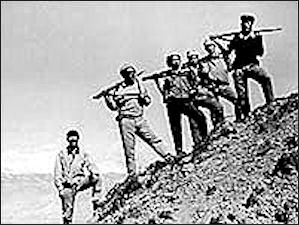
The Khams (Tibetans from the Kham province of Tibet) launched a separatist movement in the mid 1950s after their homeland was annexed by the Chinese and added to Sichuan province and they we ordered to turn in their guns.
Many Khams wore pictures of the Dalai Lama in amulets worn around their necks which they believed would protect them from bullets. For the Khams the Buddhist love of all living things did not extend to the Chinese. One guerilla in the film "Shadow Circus: The CIA in Tibet" said, “When we kill an animal, we say a prayer, But when we killed Chinese, no prayer came to our lips."
Serious fighting began in January 1956. In one attack, Chinese warplanes bombed a monastery. Thousands of Tibetan reportedly were killed. One fighter told Newsweek, "We didn't know the world. All we did know was that Chinese were killing our people, torturing the monks and destroying our temples. We thought if we are going to die anyway, we might as well die fighting rather than have our throats cut like sheep.”
Lacking money and poorly armed and supplied, the Khams approached India and Taiwan for help. New Delhi ignored them and Taipei gave them some weapons. They also met with the Gyalo Thindup, the Dalai Lama's older brother, who put the them in contact with the C.I.A.
See Separate Articles: CHINESE INVASION OF TIBET IN 1950 AND ITS AFTERMATH factsanddetails.com ; TIBETAN REVOLT IN 1959 AND THE CHINESE TAKEOVER OF TIBET factsanddetails.com ; CHINESE REPRESSION IN TIBET IN THE LATE 1950s AND EARLY 1960s factsanddetails.com ; STORY OF A MILITANT TIBETAN MONK factsanddetails.com
RECOMMENDED BOOKS:“Arrested Histories: Tibet, the CIA, and Memories of a Forgotten War” by Carole McGranahan Amazon.com; “Echoes from Forgotten Mountains: Tibet in War and Peace” by Jamyang Norbu Amazon.com; “Into Tibet: The CIA's First Atomic Spy and His Secret Expedition to Lhasa” by Thomas Laird Amazon.com; “Muslim, Trader, Nomad, Spy: China's Cold War and the People of the Tibetan Borderlands (New Cold War History)” by Sulmaan Wasif Khan Amazon.com “CIA Paramilitary Operations in Tibet: 1957-1974" by Ken Conboy Amazon.com; General History: “Tibet: A History” by Sam van Schaik Amazon.com; “A Historical Atlas of Tibet” by Karl E. Ryavec Amazon.com; “Histories of Tibet” by Kurtis R. Schaeffer , William A. McGrath, Amazon.com; “Himalaya: A Human History” by Ed Douglas, James Cameron Stewart, et al. Amazon.com; “Tibet & Its History” by Hugh Richardson (1989) Amazon.com; "Tibetan Civilization" by Rolf Alfred Stein Amazon.com; “The Story of Tibet: Conversations with the Dalai Lama” by Thomas Laird Amazon.com
C.I.A. in Tibet
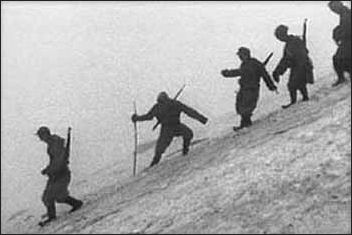
The C.I.A. agreed to help the Khams by training them in guerilla warfare and helping them run operations in Tibet against the Chinese. The lord chamberlain for the Dalai Lama and other high official were very enthusiastic about the operation. The Dalai Lama himself was skeptical about its aims and its chances of success. The operation, codenamed ST CIRCUS, was by all accounts a disaster. [Source: Melinda Lu, Newsweek, April 19, 1999]
The C.I.A. was taken by the "can-do" spirit and exoticness of the Khams. Their effort began with the training if six Tibetans in Saipan and Okinawa in the 1950s and parachuting them into Tibet to gather intelligence.
After the fighting in Tibet intensified, many Tibetans fled to a refugee camp near Darjeling, India, where the C.I.A., recruited fighters. The first of these recruits were trained by the C.I.A. and parachuted into Tibet from B-17s that took off from an airstrip near Dhaka in present-day Bangladesh. Outfit with communication equipment, they met up with resistance fighters near Lhasa and helped them coordinate their operations.
About 300 Kham recruits were flown to the United States, where they were trained in a camp near Leadville Colorado on how to use automatic weapons and espionage equipment. The Dalai Lama was once introduced to two of the C.I.A.-trained guerrillas. He asked them to demonstrate their skills. The warriors pulled out bazookas, fired them and spent 15 minutes reloading them. The Dalai Lama said, "Will you shoot once and then ask the enemy to wait 15 minutes?"
These Tibetan separatists were then infiltrated back into Tibet to fight against the Chinese. Some entered through the Mustang region in Nepal. Others were parachuted out the back of silver C-130s known to the guerrillas as "sky ships."
Film: "Shadow Circus: The CIA in Tibet"
Secret CIA War in Tibet
America's Central Intelligence Agency (CIA) Tibet Task Force a covert operation to train Tibetan guerillas in the United States and parachute them into their homeland, to fight the Chinese — ran for almost two decades (1956 to 1974) and yielded key intelligence on China. (In 1961, CIA-trained Tibetans bombed a Chinese army truck and bagged a satchel of classified documents. Among other revelations, they contained the first official evidence of the widespread famine that resulted from the agrarian reforms of the Great Leap Forward.) But mostly it was a failure. [Source: Dinah Gardner, South China Morning Post, January 30 2011]
In the last few years more and more participants in the secret war, particularly Tibetan freedom fighters have been telling their stories. Now in their 60s, 70s and 80s, most of Tibetan fighters had been monks, farmers or nomads, with little or no education, before they took up arms. Many of them speak about having witnessed Chinese soldiers kill their family and friends or destroy their monastery.
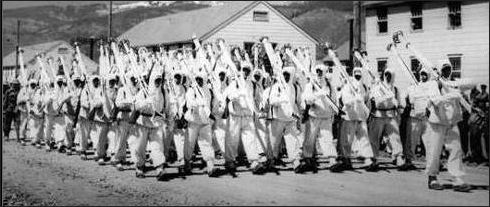
Camp Hale training
Sources About Secret CIA War in Tibet
Belgian author Birgit van de Wijer recorded the stories of 48 former Tibetan freedom fighters living in three settlement camps — Jampaling, Paljorling and Tashi Gaang — near Pokhara, Nepal — and published them in the book "Tibet's Forgotten Heroes: The Story of Tibet's Armed Resistance Against China".
"Arrested Histories: Tibet, the CIA and Memories of a Forgotten War" (2010) by Carole McGranahan,an associate professor of cultural anthropology and Tibetan studies at the University of Colorado. As part of this period of release, Lhamo Tsering (a resistance fighter who helped set up the Mustang camp with Gompo Tashi) has written a 15-volume account of the resistance. Chushi Gangdruk commander Ratu Ngawang has also recently written a book on the war. Both books have been published in Tibetan.
In 1998, Lhamo Tsering's son, Sonam Tsering, made "The Shadow Circus: The CIA in Tibet", a BBC-commissioned documentary on the secret war. Lisa Cathey, whose father Clay was involved with the CIA operation Tibet, made a documentary film about the America's Central Intelligence Agency (CIA) Tibet Task Force.
Organizers of the Secret CIA War in Tibet
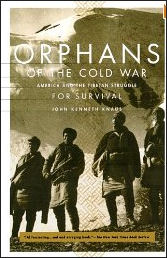
After the PLA bombed key monasteries in 1956, wealthy Tibetan businessman Andrug Gompo Tashi organized a rebel army and called it Chushi Gangdruk. He was from Litang, in modern day Sichuan province, a Tibetan town well-known for its anti-Chinese sentiment even today. [Source: Dinah Gardner, South China Morning Post, January 30 2011]
In 1957, the Dalai Lama's two brothers, who were in exile by then, put the CIA in touch with Gompo Tashi. The U.S. was keen to use the Tibetans to gather intelligence on China. Starting that year, small groups of Tibetan exiles were smuggled out of India - because of the political sensitivity, Delhi was kept in the dark - and sent to secret CIA training camps, first on Saipan, in the western Pacific, and then at Camp Hale, in Colorado, where they were taught basic spying techniques, morse code, radio operations and guerilla warfare. Co-ordinating with Chushi Gangdruk the men were parachuted back into Tibet on a mission codenamed Operation ST-Circus.
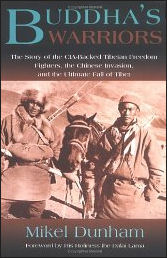
In 1959, everything changed. The Dalai Lama fled to India amid fears the Chinese were plotting his assassination. Chushi Gangdruk soldiers escorted the holy leader across the border and, to this day, many people see this as the single greatest achievement of the Tibetan resistance army. The Chinese were furious and stepped up their attacks, forcing Chushi Gangdruk and thousands of refugees to follow their god king into exile in India.
"The CIA did help but the arms we were getting during that time were not sufficient to fight the Chinese," says Ratu Ngawang, Gompo Tashi's right-hand man, in footage recorded for Cathey's documentary and made available to the South China Morning Post. "They were attacking us in brigades and all we had were old guns. They had tanks and we were running on horses. If during that time the CIA had sent the right arms and ammunition to fight, I think that would have really helped us, because during that time all the Tibetans were fearless." [Source: Dinah Gardner, South China Morning Post, January 30 2011]
Camp Hale Training and Trifling American Help in the Secret CIA War in Tibet

At Camp Hale, the Tibetan trainees were given Western names - Walt, Tom, Nathan. Bhusang was known as Ken. By all accounts, the men hit it off with their instructors, despite having to communicate through translators. One of the most authoritative published accounts of US involvement, The CIA's Secret War in Tibet, by Kenneth Conboy and James Morrison (a new edition will be published next month), relates how the Americans remember their students. [Source: Dinah Gardner, South China Morning Post, January 30 2011]
The Tibetans learned radio and parachute skills, and, for inspiration, watched the "The Bridge on the River Kwai". "They really enjoyed blowing things up during demolition class but when they caught a fly in their mess hall, they would hold it in their cupped palms and let it loose outside," Ray Starke, whose speciality was radio technology, told the South China Morning Post. The Tibetans loved to tease their American teachers. "They would intentionally leave doors open to get a rise out of me," says Starke. "I told them that when I visited them in a free Tibet, I was going to rip their tent flaps off. They thought this was hysterical."
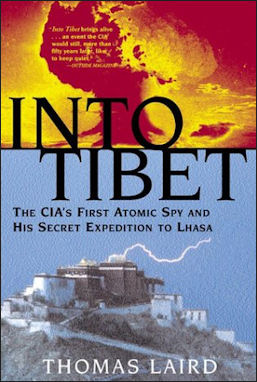
One of the tragic aspects of the secret war was the belief among the guerillas that the U.S. genuinely wanted to help them regain independence, even when the assistance given was trifling. "It wasn't even one thousandth of the help we needed," says Jamyang Norbu. "Tibetans by and large believed that the US would support the whole Tibetan cause, primarily because of America's reputation at that time," he says. "The U.S. wasn't just another colonial power like France or Britain ... it had liberated China and so on. We felt it was a wonderful thing, this help."
CIA documents relating to the Tibet Task Force are still classified. However, former CIA official Sam Halpern told The Shadow Circus documentary makers it was only ever intended as a "nuisance" mission. "I think, basically, the whole idea was to keep the Chinese occupied somehow. Nobody wanted to go to war over Tibet." But "For the majority of Tibetans with whom I worked, discomfort with American empire building on the back of the Tibetan struggle pales in comparison to the gratitude for their support," says Carole McGranahan, an associate professor of cultural anthropology and Tibetan studies at the University of Colorado.
While the CIA did not help the Tibetans win back their country, it did, say some, help them lay the foundations for a country in exile. The CIA air dropped weapons and supplies just before the Dalai Lama fled Lhasa and that helped the Chushi Gangdruk forces escort the spiritual leader and thousands of refugees across the border, notes Jamyang Norbu.
"There would never have been any Tibetan refugees because [China] would have sealed off the border. But because the guerrillas maintained this road in 1959, we had cut off the whole Chinese garrison on the way south to India."
Early Operations in the Secret CIA War in Tibet
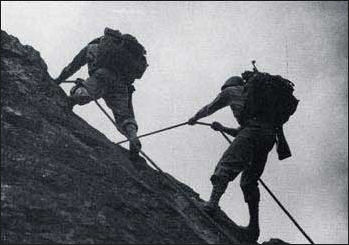
Camp Hale training Fighters reassembled, with thousands of recruits, in Mustang, just across the Tibetan border in northern Nepal. Mustang, at the time a semi-autonomous kingdom, was a good launch pad for raids into Tibet because it has relatively easy-to-traverse mountain passes across the border. At first, conditions in Mustang were extremely tough for the Tibetan fighters. There was little food. The veterans talk about having to eat boiled yak leather. It wasn't until March 1961 that the CIA made its first airdrop of supplies and weapons. The men would camp for months along the border, drawing maps, tracking movements of Chinese soldiers and occasionally shooting at troops from the hills before fleeing back across the border. [Source: Dinah Gardner, South China Morning Post, January 30 2011]
Their main target was the Lhasa-Xinjiang highway. The guerrillas attacked so many army trucks on this route that by 1964 the Chinese had stopped using that stretch, according to van de Wijer. "We were always doing guerrilla fighting and we often went into Tibet and killed Chinese soldiers," says Gonchoe. "We hid a bomb under the road, covered it and when a [Chinese] truck drove over it, it exploded. I did this three times and our group also downed an airplane."
Tsering, 79, a veteran in Paljorling camp, told van de Wijer: "I went a couple of times to Tibet to bomb the road. One time, we attacked a truck and killed 11 soldiers and took all their weapons." The CIA continued training Tibetans at Camp Hale, and parachuting them into Mustang - and Tibet itself, to encourage local resistance groups and to collect more detailed intelligence on the Chinese.
Jamyang Norbu was born in India and ran away from home when he was a teenager to join the Mustang forces. He arrived quite late in the game, in 1971, and thus missed out on the fighting. "I never got to shoot anybody," he said later. "It's my greatest regret."
Later C.I.A. Operation in Tibet
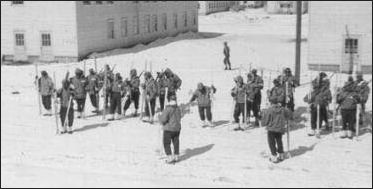
Camp Hale training
Between 1957 and 1960, 400 tons of weapons and supplies were dropped from cargo planes to resistance fighters in an operation that cost Washington about $1.7 million a year. Most of the missions were failures. Nine of ten of the guerrillas dropped into Tibet by parachute were killed by the Chinese or committed suicide to avoid capture.
In early 1958, the main Kham resistance group was surrounded by 1,000 artillery-equipped Chinese soldiers. One fighter recalled, "All our leaders were wounded. We kept hoping the C.I.A. would drop us some weapons, but they never came. I went 15 days without food — even shoe leather tasted delicious." The fighters escaped by dispersing and trekking through some of the world's harshest wilderness.
After the U-2 spy plane was shot down over the Soviet Union in 1960, the United States halted missions over Communist airspace. Guerrillas were then launched into Tibet from the Mustang.
In the mid 1960s, when the C.I.A.'s attention was directed towards Vietnam and Indochina, the Leadville facility was showdown. After concluding that the guerrilla's achievements in Tibet were "minimal" and the Tibetans "did not appear to be congenitally inclined towards conspiratorial proficiency" support for the Tibetan guerrillas was reduced and cut off completely after Nixon visited China in 1971. In 1974, Beijing pressured Nepal to shut down the Mustang camps.
In July 1974, a tape-recorded message by the Dalai Lama was delivered to the guerrillas, urging them to lay down their weapons. They agreed. Some were so distraught they decided to commit suicide by drowning themselves or slitting their throats. The last group of guerrillas made their last stand at 18,000-foot-high Tinker Pass, with many dying in a hail of gunfire. Many felt the Tibetan guerrillas were encouraged and then abandoned by the C.I.A. much as anti-Castro Cuban fighters were during the Bay of Pigs. In his autobiography the Dalai Lama wrote the guerilla mission "caused almost more harm to the Tibetans than the Chinese."
Set Backs and Failures of the Secret CIA War in Tibet
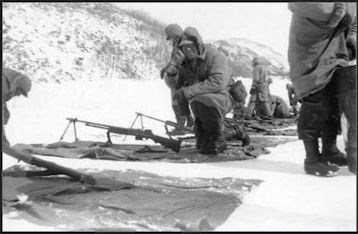
Camp Hale training Infiltrations into Tibet were mostly unsuccessful and many of the men sent in by the CIA were killed. Some local Tibetans were suspicious of the US-trained men while others were worried the Chinese would punish them for collaborating. Meanwhile, the Chinese troops were well equipped and had many informers among the villagers. [Source: Dinah Gardner, South China Morning Post, January 30 2011]
Bhusang, who was interviewed by Cathey a few months before his death in India last year, was one of seven CIA-trained guerillas dropped into eastern Tibet in March 1961. "The locals thought we were Chinese spies and they wouldn't give us any food or sell us anything and then we heard that the Chinese knew we were there," he tells Cathey.
The group fled, pursued by troops to Markham (Mangkang in Chinese), where they joined other fighters and made a stand. "The Chinese had surrounded us," he says. "Thousands and thousands; too many to count, like herds of cattle." Bhusang was the only survivor of his seven-man team. A PLA soldier hit him on the back of the head just before he got a chance to bite down on the cyanide pill he had placed in his mouth. He was to spend the next 17 ½ years in a Chinese jail.
In 1964, Gompo Tashi died from old shrapnel wounds in an Indian hospital. Cross-border raids had become sporadic and generally unsuccessful. "We got miles of tapes," CIA officer Angus Thuermer tells Conboy and Morrison, "but much of it was useless, like Chinese talking about their families back home." Internal politics destabilized the resistance and its equipment and military capabilities were lacking. In Mustang, the men would train with sticks because they didn't have enough guns.
End of the Secret CIA War in Tibet
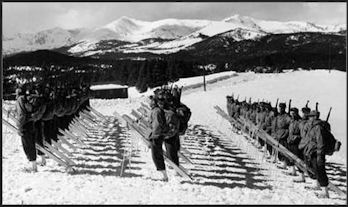
Camp Hale training In 1967, the CIA began gradually winding down the operation. In the summer of 1974, Nepal, keen to forge stronger ties with China, dispatched its army to shut down the Mustang base altogether. The Tibetans were ready to fight the Nepalese soldiers rather than surrender but, at the 11-hour, the Dalai Lama sent a taped message pleading with them to lay down their arms. A few committed suicide rather than surrender. Veterans remember that day with heavy hearts. "I was really very angry and I cried," says Pema Lhasung in van de Wijer's book. "I felt pity for myself because I couldn't take revenge for the murder [by Chinese soldiers] of my parents."[Source: Dinah Gardner, South China Morning Post, January 30 2011]
By then U.S. priorities had changed. President Nixon began to initiate diplomatic ties with Chairman Mao, and the C.I.A. dropped the operation.One of the Dalai Lama’s brothers settled in Bloomington; another moved to Hong Kong; a third went to New Jersey, where, at one point, he worked as a school custodian known as Sam.
In "Arrested Histories: Tibet, the CIA and Memories of a Forgotten War" (2010), Carole McGranahan, an associate professor of cultural anthropology and Tibetan studies at the University of Colorado, concludes that there is some truth to the theory that the resistance has been sidelined because it is a story of war and the Dalai Lama's legitimacy rests on his policy of non-violence. But the key reason, she writes, is that the resistance army challenged the status quo of aristocratic Tibetan society, in which wealthy landowners and the Buddhist clergy ruled from Lhasa. The resistance army was made up of men who had, until then, never wielded any power over the fate of the nation.
After the Secret CIA War in Tibet
After brief spells in a Nepalese jail, many of the Tibetan veterans settled in the camps near Pokhara or in Kathmandu and worked in businesses that had been set up with money from the CIA: carpet factories, handicraft workshops and a budget hotel in Pokhara, as well as a taxi firm in the Nepalese capital. In the 90s, the carpet businesses went bust. [Source: Dinah Gardner, South China Morning Post, January 30 2011]
Some veterans of the CIA war in Tibet live in three settlement camps: Jampaling, Paljorling and Tashi Gaang, near Pokhara, Nepal. The camps, paid for with money from the exiled Tibetan government and the CIA, were set up in the 70s to house the veterans following the end of the insurgency.
Over time, many of the freedom fighters left for India. A handful found homes in the West. "While some of the veterans lead comfortable lives, most are poor," McGranahan told the South China Morning Post."Some are what I call comfortably poor, with enough food to eat and a roof over their head. But others are not doing so well and rely on the generosity of friends and neighbours, especially those who are single and without a family. The Jampaling camp in Pokhara is known for being especially poor." Some of the veterans collect a small pension (US$25 a month) from the Lodrik Welfare Fund, a charity set up to look after the former fighters.
Legacy of the Secret CIA War in Tibet
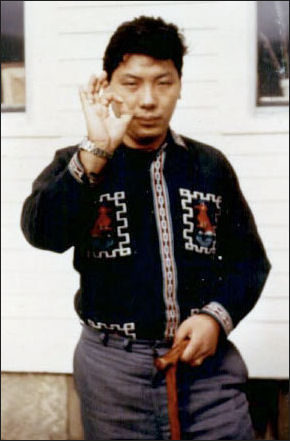
Veteran of the war "I always tell my own children ... if somebody asks you who your father is, you can be very proud because I made history," Ahnzin, a 68-year-old veteran at Jampaling, tells van de Wijer. "Never forget what I did."
"The CIA makes for a convenient bogeyman [for the Chinese] ... Discontent in Tibet can be rather neatly blamed on outside foreign agitation," says Jeremiah Jenne, a history researcher at the University of California, Davis.
"Veterans [have accepted the suppression of their history] because they see it as coming from the Dalai Lama," says McGranahan. "Betrayed is not the emotion these men feel. Frustration, yes, but betrayal, no. The reason why is because of their overwhelming devotion to the Dalai Lama as religious leader as well as political leader." "They all support the Dalai Lama's stance," Cathey says. "Their generation is still extremely loyal to him and wouldn't go against his views, regardless of their personal feelings."
Shortly before his death Bhusang said, "All these years I've been treated like an animal. I've been tortured on and on and still I've been able to survive. Whenever the Chinese tortured me, I thought: 'Such people exist in the world and we have done nothing to them.' I pray to the Dalai Lama and am proud of it - proud I have been able to survive and to have done my bit when I was in my own country."
Image Sources: Amazon, 99th infantry battlion, Free Tibet, mystic bourgeoisie
Text Sources: New York Times, Washington Post, Los Angeles Times, Times of London, The Guardian, National Geographic, The New Yorker, Time, Newsweek, Reuters, AP, Lonely Planet Guides, Compton’s Encyclopedia and various books and other publications.
Last updated July 2011
